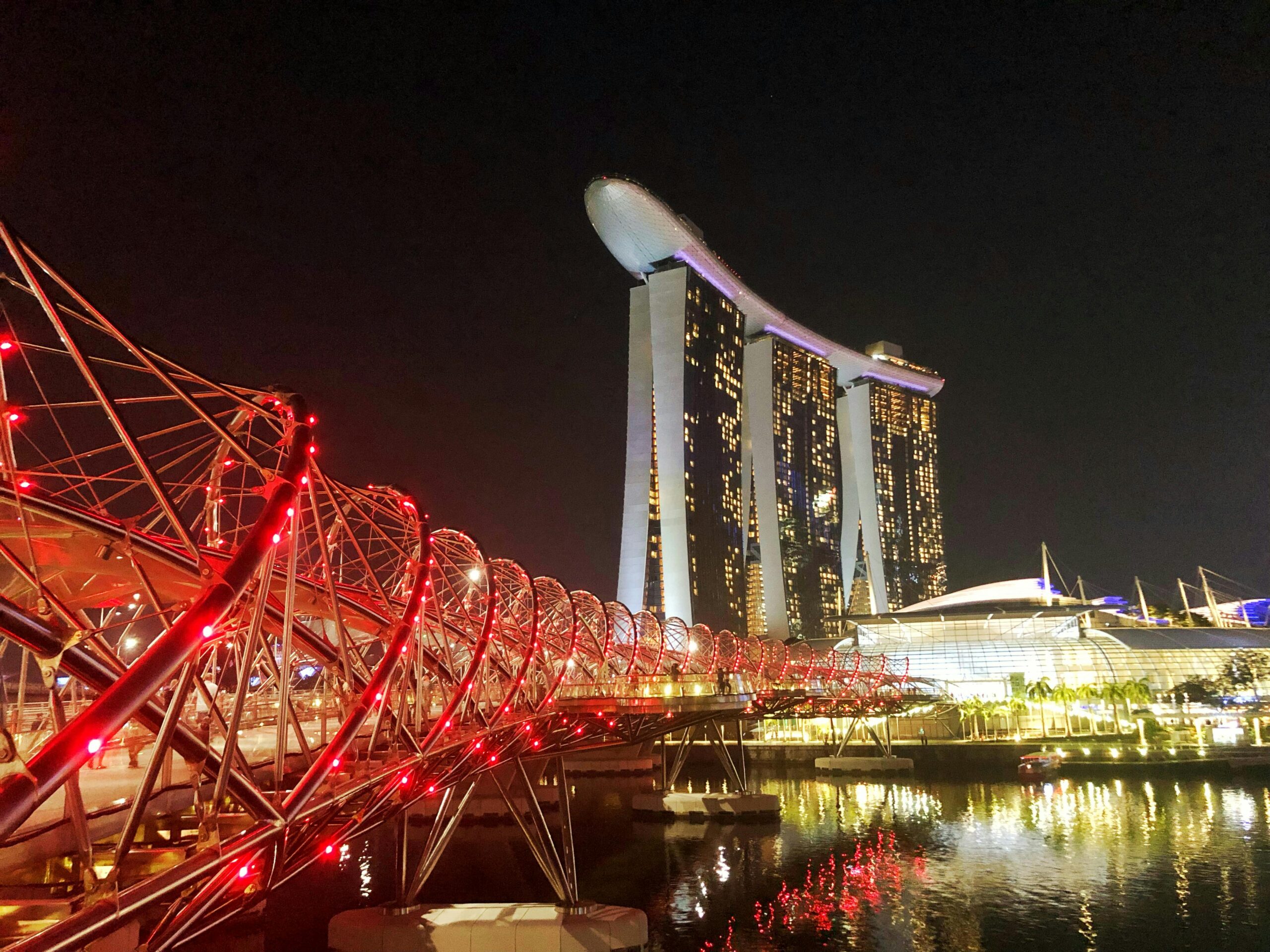While no individual market can compete with China in terms of sheer magnitude, the world’s focus on South East Asia has led to the development of large exhibition markets in, among other destinations, Singapore. It continues to punch well above its weight in the world of international exhibitions.
Perhaps most interestingly, Singapore, with a population of just five-and-a-half million people, faces much of its fiercest competition internally. Indeed, there is more quality exhibition space in this small city-state than in the whole of India.
Singapore’s market developed at roughly the same time as Hong Kong was developing its own international exhibition industry. The first major steps in the development of international trade fair activity in South East Asia took place here. Just as it is today, Singapore was initially seen by many as the destination of choice for the Asian edition of European shows; it garnered a strong reputation for its pro-business environment and knowledge economy, and supported by reliability, quality, productivity and enforcement of IP rights, it inevitably became one of the world’s leading locations for innovation and research.
Loose parallels between the venues in Hong Kong and Singapore are appropriately drawn for AsiaWorld-Expo shares much in common with one of Singapore’s largest venues, Singapore Expo, both in location and profile, while HKCEC closely resembles Suntec or – location-wise – Marina Bay Sands. Expand that comparison beyond the venues, however, and the similarities diminish.
In the early Eighties the Singapore Port Authority began converting warehouse space and re-designating it as exhibition halls. At that point there was relatively little development elsewhere in South East Asia. In time the Authority was to become the owner of Singapore Expo.
Another of the city’s venues, Suntec, also sprang from the Singapore Government’s wish in the mid-Eighties to find a purpose-built facility for hosting major international events. As a result the Suntec Singapore International Convention and Exhibition Centre (Suntec) was developed by private investors and officially opened in 1995, growing to join Singapore Expo as one of the largest multi-purpose convention and exhibition facilities.
These two were joined in 2010 by the imperious three-towered Marina Bay Sands, owned and managed by the Las Vegas-based Sands casino brand. It offered a broader proposition than both of the other venues, adding – in addition to an exhibition hall and casino – a shopping mall, museum, two theatres and an ice-skating rink. It also sits alongside the Formula 1 motor racing circuit.
Its distinct economic history, lacking the large-scale manufacturing base that exists in China and India, means that Singapore generally focuses on non-industrial exhibitions. Increasingly, more technology and lifestyle events are making their presence felt, almost certainly a result of the large number of multinationals based in the city.
“Overall, the exhibition business market in Singapore is still vibrant, although its growth might not have been as fast or robust as cities such as Bangkok, Hong Kong and Shanghai,” admits Edward Liu, group managing director of organisers Conference and Exhibition Management Services Singapore. “None the less, the number of exhibitions is still increasing. Singapore remains an attractive venue for the staging of international exhibitions in view of its regional and strategic hub in the Asia Pacific Rim. This is reinforced by the presence of thousands of multinational corporations with regional headquarters based in Singapore.”
In much the same way that Hong Kong developed a reputation for facilitating business with the surrounding Chinese market, the ease of doing business in Singapore is the source of much of its allure for international companies. Stephen Tan, chief executive of Singapore Exhibition Services and president of the Allworld Exhibitions Alliance, highlights how simple it is to travel to Singapore, and mentions both the cultural and business measures designed to make the country an appealing destination:
“We have no customs and excise duties except for tobacco, alcohol and cars,” he says. “We also believe there are lower corporate taxes compared to other countries in the region.”
Its exhibition industry also has a reputation for being progressive in nature. For example, the MAX Atria situated at Singapore Expo is both the first MICE venue in Singapore to offer organisers and delegates complimentary high-performance Wi-Fi, and the first to be awarded the Green Mark Platinum sustainability certificate by Singapore’s Building and Construction Authority. Suntec, nearer the centre of the city, claims to be home to the world’s largest video wall.
Much of the industry’s significance is derived from the fact that it feeds its industry by ensuring traction with other elements of the local economy. Singapore Expo, for example, works with local tertiary institutions at different levels of involvement in order to improve the industry’s exposure and appeal to students – the next generation of exhibition organisers and venue management teams. Among the partnering institutions are Singapore’s Institute of Technical Education, where special student attachments and internships are offered. The venue also works with Singapore’s Republic Polytechnic to offer students the chance to experience events as part of their curriculum. The provision of earning opportunities for future industry leaders helps to sustain the inventive and progressive culture that has enabled little Singapore to maintain such a high profile in the global exhibition marketplace.

Singapore’s reputation for forward-thinking business practices has also led to the establishment of international partnerships, much like we’ve already seen with the German venues and their international organising arms. Suntec, through its Suntec International division, forged a partnership with the Adelaide Convention Centre in Australia, which saw it assume sales and marketing duties to bring business from South East Asia and Australia, shared between both venues.
“The type of industries that Singapore is strong in differs from Hong Kong, Indonesia and Malaysia,” says Suntec spokesman Ong Wee Min. “In many ways, we are less brick and mortar and more content and high technology driven because of the type of industries present in the country.”
The city-state is also able to play quite heavily on its compact nature, another draw for any destination trying to attract international business travellers. Outside of the exhibition hall, people like to feel they have some sort of understanding of the places they visit. Singapore actively trades on this fact.
Resorts World Sentosa, based on an island in Singapore’s south, is a partner of Suntec. According to the venue’s business event vice-president Paul Stocker, Singapore continues to grow as a tourist destination, with attractions such as the world’s largest oceanarium at the Marine Life Park and its famous night safari continuing to attract new and returning tourists. He claims – justifiably – that Singapore has come a long way in a short time: “The development of this island nation from a small fishing village to a modern world city in less than 50 years has been nothing short of extraordinary, and brings with it a stable government focused on economic development and infrastructure,” he explains. “Another of the country’s pertinent characteristics is its strong governance and planning. Singapore is well known for its infrastructure and as a port city, but less so as a tourist destination.”
Perhaps the toughest task for Singapore is that of presenting it as an attractive destination for wider tourism business. Exhibitions and large-scale business events are much else besides a hall full of temporary stands, buyers and sellers. The city-state sits on the Malay Archipelago, which it shares with hot tourist destinations such as Malaysia, Indonesia and the Philippines. Further north you have Thailand, another strong and ambitious destination for business events. While Thailand is known around the world for the Full Moon Party that attracts hundreds of thousands of revellers every year, Singapore is known around the world for a particularly stringent law on dropping chewing gum in public. It’s no easy feat to compete with these other locations for post- and pre-event activities, and it is this fact that perhaps explains Singapore’s intense drive to appeal to the trade show and convention market.
The desire to combat its slightly sterile image is what drove the Singapore Government to revamp the nation’s tourism landscape in 2005 by introducing the concept of integrated resorts; it is hoped that integrated resorts will prompt tourists from around the world to reconsider Singapore as a destination, both for business and leisure.
The formation in 2015 of the ASEAN Economic Community (AEC), which took the Association of South East Asian Nations established in 1967, introduced economic integration initiatives in an effort to create a single market across all member nations, that really began a significant new chapter in Singapore’s development. It was to be a catalyst for the foundation of numerous collaborations and partnerships in South East Asia. This means that facilities and services aside, today Singapore provides access to a common market of 600 million across the ASEAN region.
Among the AEC’s other benefits, the development of a single market and production base, increased fairness in economic development, and increased regional representation and integration with the wider global economy strengthens the individual industrial prowess of all its member states. Its key areas of co-operation play very well into Singapore’s hands. Development of human resources, a focus on professional qualifications, trade financing, improved infrastructure and communications connectivity and the development of electronic transactions, alongside closer consultation on macroeconomic and financial policies are already evident in Singapore. Indeed, to some extent Singapore is the model on which such regional aspirations may be based.
It also enables Singapore, by association with the AEC, to compete more directly with the alliance illustrated in the previous chapter between China and Hong Kong. Integrating industries across the region for joint promotion of regional sourcing and improved private sector involvement, for such a large combined population, makes the AEC perhaps the leading market for commercial sourcing and natural resources. China already sources many of its raw materials from South East Asia, and facilitated by the free movement of skilled labour, goods, services and plentiful external and internal investment, the ASEAN alliance will surely make its mark as a single market.
In idealistic terms, with each member’s strength now the sum of each other’s strengths, Singapore can rightly be expected to benefit greatly from its already prominent reputation. It can offset its shortcomings as a colourful destination through association with its more populous and glamorous neighbours. As with the foundation of the European Union in 1993 or the Gulf Cooperation Council of 1981 (now the Cooperation Council for the Arab States of the Gulf), this expanded alliance is likely to improve Singapore’s profile and cement its appeal as a central point of contact with the rest of the South East Asian nations.
The region is working hard to develop these relationships. In Thailand, for example, the director of the exhibition department at the national convention and exhibition bureau TCEB, Supawan Teerarat, said that as head of a government agency dedicated to promoting the exhibition industry, she is “keenly aware” of the importance of regional cooperation to boost the growth of the exhibition industry:
“We expect the economic integration within ASEAN to drive a major expansion of the exhibition industry in South East Asia,” she says. “It is therefore crucial to develop multi-faceted bilateral co-operation with other member countries to contribute to ASEAN prosperity and development in the region.”
Besides established exhibitions such as Food & Hotel Asia, Communic Asia and the Singapore Airshow, Singapore is well known for its financial and medical services, hosting several regular international congresses. More and more established events are consolidating their positions in Asia, while newer events are entering, catering to niche segments. At the same time, large international exhibition organisers such as Reed, UBM and ITE are using Singapore as a base to reach out directly to places such as Malaysia and Indonesia, both registering strong economic growth and development in recent years.
Michelle Lim, Reed’s managing director for Singapore, Malaysia and Indonesia, says Singapore has a competitive advantage over the rest of the region in a variety of sectors:
“Singapore is known to be a strong maritime hub, champions the green built environment, and these have worked well for APM and BEX Asia,” she points out. “Its small country size and neutrality for media content development means it would not be seen as overshadowing the market on content rights and culture development issues. Singapore’s strong IP rights has also helped in events such as [originally Paris-based event] Maison&Objet.”
Reed’s other events include Asia Pacific Maritime, Asia Television Forum/Screen Singapore, Build Eco Xpo Asia and the Singapore Toys Games & Comic Convention. Evidently, this organiser sees Singapore as a market of choice for its ‘Asia’ show editions.
Of course, operating in Singapore is not always straightforward, even for Reed. “With Singapore being ranked most expensive city for expatriates recently in one of the reports, it does provide challenges to attract exhibitors and visitors as the overall participation costs are perceived to be a lot higher than that of our neighbouring countries,” says Lim. “As such, Singapore needs to continue to improvise and provide differentiation and value-added experience.”
Lim also believes Singapore needs to spend time bringing more of the ASEAN region to its events: “As customers and industries increasingly operate on a global scale, there are expectations for Singapore events to deliver more regional visitors to the events,” she says. “Singapore’s status as a business events hub supported by regional connectivity, overall efficiency, quality hotels and MICE facilities and multi-lingual populace will remain relevant and competitive. Singapore will need to enhance its total offering to improve on visitor experience.”

One of the initiatives on which Singapore is taking a global lead is in focusing on attracting business clusters, as opposed to individual events. Business travellers are a particularly time-poor lot, and it is hoped that the act of amalgamating events that span common industries will improve the city’s global marketing. “Business travellers are often strapped for time when attending overseas exhibitions and conferences. Clustering or co-locating complementary business events allows them to optimise their business trips and maximise networking opportunities across the different events, within the same eco-system,” says Andrew Phua, director of exhibitions and conferences at the Singapore Tourism Board (STB).
An example of this is the cluster event Singapore Design Week, which took place in March 2014 and featured local and international design trade shows (for example, International Furniture Fair Singapore and Maison&Objet Asia), conferences, showcases, exhibitions and workshops spanning various design disciplines.
Another cluster event, TravelRave, gathers together travel business events such as the Asia Travel Leaders Summit and ITB Asia every October. TravelRave has been created by STB to provide a platform for thought leaders in the travel and tourism industry to come together, exchange insights and explore opportunities offered by the growth of tourism in Asia.
“In the past, our focus was more volume-driven, with the aim of attracting a high number of events. In recent years, we started to take a more visitor-centric approach, and our focus is now more quality-driven,” says Phua. “Today, a deeper understanding of delegate needs and strengthening the industry capabilities to meet those needs, form the basis of proposing the right products and services to international organisers.
“Singapore has built strengths in industries such as biomedical and healthcare, banking and finance, science and technology, design, travel, media and digital content and urban solutions. Our focus is therefore on attracting MICE events that complement these industries,” says Phua.
The rise of the exhibition market in Asia has also provided further opportunities, given Singapore’s global trade and communications networks and ability to provide market access and facilitate trade flows between Asia, the Pacific and the rest of the world. By drawing established industry players, opinion leaders and decision makers from around the globe, these events augment Singapore’s position as a thought leader and knowledge hub in the region.
Singapore remains one of the first and most successful events markets in South East Asia. But with all this space in such a small destination, is there an argument for there being too many venues in Singapore?
Marc Bakker, Suntec’s marketing director thinks not. His venue underwent a SGD184m modernisation programme in June 2013, and today offers 42,000sqm of customisable space designed to minimise turnaround times and seamlessly transition from exhibition hall to conference space to ballroom. “The MICE industry in Asia has always operated in a competitive business climate,” he says. “As such, having a wider choice of venues in Singapore, combined with the country’s natural vibrancy and attractions, has raised the profile of Singapore as an appealing MICE destination overall.”
In other words, he believes that there is a halo effect from the presence of so many international-standard venues in Singapore that benefits the whole industry. But as is the case in any competitive market, success requires sufficient differentiation in order to facilitate that degree of specialisation that allows a product – in this case the venues – to carve out their own niche. The global demand evidently still exists.
As a thriving financial centre and an important information exchange and trading hub, Singapore provides the essential conditions for businesses looking to establish a foothold in the Asian marketplace. “With increasing competition from the region, including South Korea, Hong Kong and Thailand, Singapore needs to continuously evolve and be more diligent in attracting international event organisers,” says the CEO of Singapore Expo’s parent company SingEx, Aloysius Arlando. “It needs to pull the entire MICE industry together to see how we can add more value, and address the exacting needs of international organisers.”
Singapore is an appealing destination to exhibition and meeting organisers due to its combination of a vibrant business ecosystem, robust economy and knowledge networks, and diverse leisure activities; it is, for some organisers, the most strategic location in a resurgent Asia.


Leave a Reply